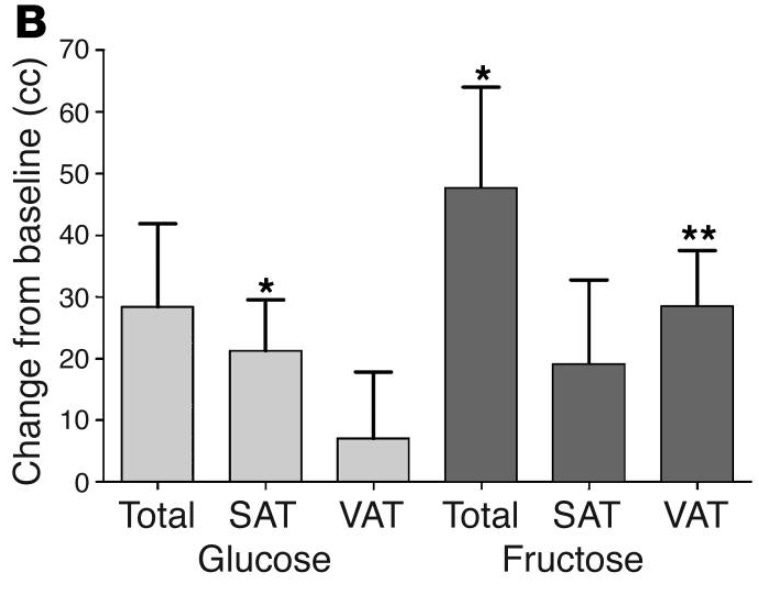Optimize your physique
Improving your body composition obviously involves decreasing body fat and increasing muscle, but how do you know if you’ve lost enough fat, and how do you know if you’ve built up enough muscle? Here is your guide:
Optimize body fat
With regard to losing body fat, there are two main types of fat you need to be aware of: subcutaneous and visceral. Subcutaneous fat is the fat you can pinch. Losing subcutaneous fat is especially important for men1. Pre-menopausal women are designed to have more subcutaneous fat and so they should be less concerned about it.2 Losing subcutaneous fat is fairly straightforward. It’s basic thermodynamics: burn more calories than you consume.
Losing visceral fat, however, is an entirely different ballgame. Visceral fat is the fat deep within your abdomen, around your abdominal organs. Have you seen someone who is generally skinny but who has a bowling ball for a belly? That person is almost exclusively burdened with visceral fat. A basic calories-in/calories-out strategy is not going to help that person. In order to understand why, you have to understand a key physiological difference between subcutaneous fat and visceral fat. Subcutaneous fat serves as an energy depot for your entire body. So, you can easily burn it with any form of exercise. By contrast, visceral fat is an energy depot exclusively for your liver.3 You can only burn it by “working out” your liver.
How do you “workout” your liver? The best way to do this is to engage in a form of exercise that causes a burning sensation in your muscles.4567 That burning sensation means that your muscles are producing lactate. This lactate is sent to your liver, where it is converted into glucose, which can then be sent back to your working muscles. Where does your liver get the energy to make this conversion? You guessed it, from your visceral fat depot!
Of course, this will only be effective if your liver is in good working order. You can ensure this by getting sufficient nutrients, especially choline,8 and by avoiding toxic overload of various compounds (heavy metals, oxalate, alcohol), as discussed in other sections of this manual. You will also not want to overload your liver with too much fructose. Here is a study comparing the effects of a fructose-sweetened drink to a glucose-sweetened drink on visceral fat (VAT) and subcutaneous fat (SAT) accumulation:9
The above study used refined fructose. Regarding fructose in fruit and fruit juice, most people can tolerate a considerable amount. For example, 3 cups a day of orange juice did not increase the waist circumference of normal weight or overweight individuals.10 Individual results may vary.
Lastly, studies have shown that visceral fat can be reduced by engaging in fasting protocols,11121314 by eating fermented foods,15 by avoiding excess vitamin A,16 by consuming more fiber and protein,171819 and by getting enough omega-3 fat.20
Optimize muscle mass
Having more muscle improves your insulin sensitivity, lessening your chances of developing diabetes.2122 It increases your lifespan.2324 It improves your mental health.252627 It makes you look good naked.28
How do you build more muscle? Two steps: First, get between 1.2 and 1.6 grams of protein per kilogram estimated ideal body weight,29 and second, move heavy objects.
But how do you know what your estimated ideal body weight is? Initially, you can just use the charts and calculators that are readily available on the internet. The ones that take into account not only your height but the size of your skeletal frame are the most accurate.30 This calculation is just a rough starting point, to be later modified (see below).
How do you know if you have enough muscle? Before you can begin to assess your muscle mass properly, you first have to lose enough fat such that your waist-to-height ratio is less than 0.5.31 Measure your waist circumference with a tape measure at the level of your belly button, or slightly below, whichever is larger. If your ratio is greater than 0.5, target subcutaneous and/or visceral fat as described above. Once you have achieved a ratio of 0.5, you are now ready to assess muscle mass using another calculator available online called an ABSI calculator, also known as the body shape index.32333435 This calculator uses your waist circumference and your body weight to estimate your overall body composition. Specifically, at a given waist circumference you will want a higher body weight, as this indicates relatively larger amounts of muscle mass and/or bone mass. If after entering your parameters into the ABSI calculator, your risk category is anything but “very low,” you need to gain weight in the form of muscle mass, while still maintaining a waist-to-height ratio of 0.5. This is more difficult than it sounds, and it make take months or years. Lift weights, perform body weight exercises like push-ups and pull-ups, sprint, and/or engage in strenuous sports activities until you build up enough muscle such that you are in the "very low” risk category on the ABSI calculator. You are now at your true ideal body weight. Adjust your protein intake accordingly.
https://ajronline.org/doi/10.2214/AJR.11.7361
https://pmc.ncbi.nlm.nih.gov/articles/PMC9258798/
https://pubmed.ncbi.nlm.nih.gov/15173878/
https://pubmed.ncbi.nlm.nih.gov/15598677/
https://pmc.ncbi.nlm.nih.gov/articles/PMC6085472/
https://pubmed.ncbi.nlm.nih.gov/17209176/
https://pubmed.ncbi.nlm.nih.gov/28116314/
https://pubmed.ncbi.nlm.nih.gov/26773011/
https://pmc.ncbi.nlm.nih.gov/articles/PMC2673878/
https://pubmed.ncbi.nlm.nih.gov/26490535/
https://pubmed.ncbi.nlm.nih.gov/27240637/
https://pubmed.ncbi.nlm.nih.gov/33441502/
https://pubmed.ncbi.nlm.nih.gov/36531168/
https://pubmed.ncbi.nlm.nih.gov/36220069/
https://pubmed.ncbi.nlm.nih.gov/30845686/
https://pubmed.ncbi.nlm.nih.gov/25900735/
https://pubmed.ncbi.nlm.nih.gov/27483317/
https://pubmed.ncbi.nlm.nih.gov/21681224/
https://pubmed.ncbi.nlm.nih.gov/17023705/
https://pubmed.ncbi.nlm.nih.gov/31774300/
https://www.degruyterbrill.com/document/doi/10.1515/jbcpp-2021-0316/html
https://pmc.ncbi.nlm.nih.gov/articles/PMC7483278/
https://pubmed.ncbi.nlm.nih.gov/24561114/
https://pubmed.ncbi.nlm.nih.gov/37285331/
https://pmc.ncbi.nlm.nih.gov/articles/PMC11799061/
https://pmc.ncbi.nlm.nih.gov/articles/PMC7460504/
https://pmc.ncbi.nlm.nih.gov/articles/PMC9398224/
Find a mirror
https://pubmed.ncbi.nlm.nih.gov/31794597/
https://www.calculator.net/ideal-weight-calculator.html?ctype=standard&cage
https://pubmed.ncbi.nlm.nih.gov/25198730/
https://www.omnicalculator.com/health/a-body-shape-index
https://pubmed.ncbi.nlm.nih.gov/26160362/
https://pubmed.ncbi.nlm.nih.gov/22815707/
https://pubmed.ncbi.nlm.nih.gov/35541302/


